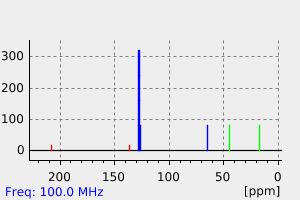2-苯基环丁壬 | 42436-86-2
中文名称
2-苯基环丁壬
中文别名
2-苯基环丁酮
英文名称
2-phenylcyclobutanone
英文别名
2-phenylcyclobutan-1-one
CAS
42436-86-2
化学式
C10H10O
mdl
MFCD19382274
分子量
146.189
InChiKey
BJFZFQHWYGJPQD-UHFFFAOYSA-N
BEILSTEIN
——
EINECS
——
-
物化性质
-
计算性质
-
ADMET
-
安全信息
-
SDS
-
制备方法与用途
-
上下游信息
-
文献信息
-
表征谱图
-
同类化合物
-
相关功能分类
-
相关结构分类
物化性质
-
沸点:116 °C(Press: 7 Torr)
-
密度:1?+-.0.06 g/cm3(Predicted)
-
溶解度:可溶于氯仿(少许)、甲醇(少许)
计算性质
-
辛醇/水分配系数(LogP):1.7
-
重原子数:11
-
可旋转键数:1
-
环数:2.0
-
sp3杂化的碳原子比例:0.3
-
拓扑面积:17.1
-
氢给体数:0
-
氢受体数:1
安全信息
-
海关编码:2914399090
SDS
上下游信息
-
下游产品
中文名称 英文名称 CAS号 化学式 分子量 2-苯基环戊烷-1-酮 2-Phenylcyclopentanone 1198-34-1 C11H12O 160.216 3-苯基环戊酮 3-phenylcyclopentanone 64145-51-3 C11H12O 160.216
反应信息
-
作为反应物:参考文献:名称:可见光驱动、铜催化的环烷酮需氧氧化裂解摘要:已经提出了一种可见光驱动的、铜催化的环烷酮有氧氧化裂解。具有不同环大小和各种α-取代基的各种环烷酮反应良好,以中等至良好的产率得到远端酮酸或二羧酸。DOI:10.1021/acs.joc.1c00708
-
作为产物:描述:参考文献:名称:有效合成环丙基甲硅烷基酮摘要:研究了正丁基锂存在下甲硅烷基环丙基溴与二氯甲基甲基醚的反应。在碱性反应条件下,仅获得相应的环亚丙基衍生物。将得到的环亚丙基化合物进行质子分解或一锅中用亲电子试剂捕集,以高收率得到环丙基甲硅烷基酮衍生物。对衍生的环丙基甲硅烷基酮进行酸性处理,可以进行异构化,从而独家获得热力学上有利的转化形式。DOI:10.1016/j.tet.2011.10.013
文献信息
-
Stereoselective synthesis of α-disubstituted cyclopentanones by palladium-catalyzed rearrangement of allenylcyclobutanols with aryl halides作者:Masahiro Yoshida、Kenji Sugimoto、Masataka IharaDOI:10.1016/s0040-4020(02)00910-9日期:2002.9When allenylcyclobutanols having a 1-substituted allenyl group were treated with aryl iodides in the presence of palladium(0), ring-expanded cyclopentanones possesing quaternary carbon stereocenter at the α-position were stereoselectively obtained. The reactions can be applied to various kinds of allenylcyclobutanols and aryl halides.
-
Palladium-catalysed cascade ring expansion reaction of cyclobutanols that have a propargylic moiety with nucleophiles作者:Masahiro Yoshida、Yuki Komatsuzaki、Hideo Nemoto、Masataka IharaDOI:10.1039/b410362a日期:——Cascade ring rearrangement of four-membered ring systems containing various propargylic components by a palladium catalyst is described. The reactions of cyclobutanols that have a propargylic carbonate moiety with phenols as nucleophiles produce phenoxy-induced cyclopentanones in high yields. The reactions proceed in a regio- and diastereoselective manner to afford the substituted cyclopentanones with
-
Oxidation of Nonactivated Anilines to Generate <i>N</i>-Aryl Nitrenoids作者:Tianning Deng、Wrickban Mazumdar、Russell L. Ford、Navendu Jana、Ragda Izar、Donald J. Wink、Tom G. DriverDOI:10.1021/jacs.9b13599日期:2020.3.4and selective C-NAr and C-C bond formation to yield spirocyclic- or bicyclic 3H-indoles or benzazepinones. Our experiments demonstrate the breadth of these oxidative processes, uncover underlying fundamental elements that control selectivity and demonstrate how the distinct reactivi-ty patterns embedded in N-aryl nitrenoid reactive intermediates can enable access to functionalized 3H-indoles or benzazepinones
-
COMPOUNDS FOR THE TREATMENT OF PAIN申请人:Alkermes, Inc.公开号:US20190241524A1公开(公告)日:2019-08-08Provided herein are compounds that are useful in the treatment of pain in a subject.提供在本文件中的化合物可用于治疗主体的疼痛。
-
[EN] QUINOLIN-4-ONE AND 4(1H)-CINNOLINONE COMPOUNDS AND METHODS OF USING SAME<br/>[FR] COMPOSÉS DE QUINOLIN-4-ONE ET DE 4(1H)-CINNOLINONE ET PROCÉDÉS D'UTILISATION ASSOCIÉS申请人:FREQUENCY THERAPEUTICS INC公开号:WO2020163816A1公开(公告)日:2020-08-13The present disclosure relates to quinolin-4-one and 4(1H)-cinnolinone compounds and methods of using them to induce self-renewal of stem/progenitor supporting cells, including inducing the stem/progenitor cells to proliferate while maintaining, in the daughter cells, the capacity to differentiate into tissue cells.
表征谱图
-
氢谱1HNMR
-
质谱MS
-
碳谱13CNMR
-
红外IR
-
拉曼Raman
-
峰位数据
-
峰位匹配
-
表征信息
同类化合物
(βS)-β-氨基-4-(4-羟基苯氧基)-3,5-二碘苯甲丙醇
(S,S)-邻甲苯基-DIPAMP
(S)-(-)-7'-〔4(S)-(苄基)恶唑-2-基]-7-二(3,5-二-叔丁基苯基)膦基-2,2',3,3'-四氢-1,1-螺二氢茚
(S)-盐酸沙丁胺醇
(S)-3-(叔丁基)-4-(2,6-二甲氧基苯基)-2,3-二氢苯并[d][1,3]氧磷杂环戊二烯
(S)-2,2'-双[双(3,5-三氟甲基苯基)膦基]-4,4',6,6'-四甲氧基联苯
(S)-1-[3,5-双(三氟甲基)苯基]-3-[1-(二甲基氨基)-3-甲基丁烷-2-基]硫脲
(R)富马酸托特罗定
(R)-(-)-盐酸尼古地平
(R)-(-)-4,12-双(二苯基膦基)[2.2]对环芳烷(1,5环辛二烯)铑(I)四氟硼酸盐
(R)-(+)-7-双(3,5-二叔丁基苯基)膦基7''-[((6-甲基吡啶-2-基甲基)氨基]-2,2'',3,3''-四氢-1,1''-螺双茚满
(R)-(+)-7-双(3,5-二叔丁基苯基)膦基7''-[(4-叔丁基吡啶-2-基甲基)氨基]-2,2'',3,3''-四氢-1,1''-螺双茚满
(R)-(+)-7-双(3,5-二叔丁基苯基)膦基7''-[(3-甲基吡啶-2-基甲基)氨基]-2,2'',3,3''-四氢-1,1''-螺双茚满
(R)-(+)-4,7-双(3,5-二-叔丁基苯基)膦基-7“-[(吡啶-2-基甲基)氨基]-2,2”,3,3'-四氢1,1'-螺二茚满
(R)-3-(叔丁基)-4-(2,6-二苯氧基苯基)-2,3-二氢苯并[d][1,3]氧杂磷杂环戊烯
(R)-2-[((二苯基膦基)甲基]吡咯烷
(R)-1-[3,5-双(三氟甲基)苯基]-3-[1-(二甲基氨基)-3-甲基丁烷-2-基]硫脲
(N-(4-甲氧基苯基)-N-甲基-3-(1-哌啶基)丙-2-烯酰胺)
(5-溴-2-羟基苯基)-4-氯苯甲酮
(5-溴-2-氯苯基)(4-羟基苯基)甲酮
(5-氧代-3-苯基-2,5-二氢-1,2,3,4-oxatriazol-3-鎓)
(4S,5R)-4-甲基-5-苯基-1,2,3-氧代噻唑烷-2,2-二氧化物-3-羧酸叔丁酯
(4S,4''S)-2,2''-亚环戊基双[4,5-二氢-4-(苯甲基)恶唑]
(4-溴苯基)-[2-氟-4-[6-[甲基(丙-2-烯基)氨基]己氧基]苯基]甲酮
(4-丁氧基苯甲基)三苯基溴化磷
(3aR,8aR)-(-)-4,4,8,8-四(3,5-二甲基苯基)四氢-2,2-二甲基-6-苯基-1,3-二氧戊环[4,5-e]二恶唑磷
(3aR,6aS)-5-氧代六氢环戊基[c]吡咯-2(1H)-羧酸酯
(2Z)-3-[[(4-氯苯基)氨基]-2-氰基丙烯酸乙酯
(2S,3S,5S)-5-(叔丁氧基甲酰氨基)-2-(N-5-噻唑基-甲氧羰基)氨基-1,6-二苯基-3-羟基己烷
(2S,2''S,3S,3''S)-3,3''-二叔丁基-4,4''-双(2,6-二甲氧基苯基)-2,2'',3,3''-四氢-2,2''-联苯并[d][1,3]氧杂磷杂戊环
(2S)-(-)-2-{[[[[3,5-双(氟代甲基)苯基]氨基]硫代甲基]氨基}-N-(二苯基甲基)-N,3,3-三甲基丁酰胺
(2S)-2-[[[[[((1S,2S)-2-氨基环己基]氨基]硫代甲基]氨基]-N-(二苯甲基)-N,3,3-三甲基丁酰胺
(2S)-2-[[[[[[((1R,2R)-2-氨基环己基]氨基]硫代甲基]氨基]-N-(二苯甲基)-N,3,3-三甲基丁酰胺
(2-硝基苯基)磷酸三酰胺
(2,6-二氯苯基)乙酰氯
(2,3-二甲氧基-5-甲基苯基)硼酸
(1S,2S,3S,5S)-5-叠氮基-3-(苯基甲氧基)-2-[(苯基甲氧基)甲基]环戊醇
(1S,2S,3R,5R)-2-(苄氧基)甲基-6-氧杂双环[3.1.0]己-3-醇
(1-(4-氟苯基)环丙基)甲胺盐酸盐
(1-(3-溴苯基)环丁基)甲胺盐酸盐
(1-(2-氯苯基)环丁基)甲胺盐酸盐
(1-(2-氟苯基)环丙基)甲胺盐酸盐
(1-(2,6-二氟苯基)环丙基)甲胺盐酸盐
(-)-去甲基西布曲明
龙蒿油
龙胆酸钠
龙胆酸叔丁酯
龙胆酸
龙胆紫-d6
龙胆紫







